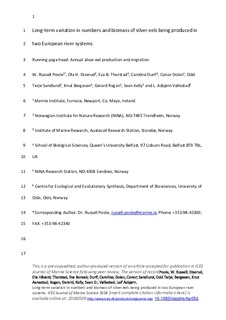| dc.description.abstract | The European eel (Anguilla anguilla) population has been in decline at least since the 1960s and reliable regional information, particularly on the spawner production and escapement (i.e. the silver eel life stage), is a requirement of the EU stock recovery regulation. Two comparable time series exist in Burrishoole (Ireland) and Imsa (Norway), with monitoring of total silver eel production since the early 1970s. Numbers of emigrating silver eels fell significantly (p < 0.0001) in the 1980s (breakpoints: Burrishoole 1982; Imsa 1988), in both catchments from >4000 eels per annum to ∼2000 eels per annum. The proportion of male eels dropped and the average size of female eels increased. Biomass of silver eels escaping has remained similar in Burrishoole (1.1/1.2 kg/ha), but not in Imsa (2.1/0.9 kg/ha) between the early period and the 2000s. Factors that govern the onset of eel maturation (silvering) and the annual production of silver eels are little understood. In this paper, the influence of time-lagged environmental variables on silver eel production is examined. Annual variation in the time series was partly (r2 Burrishoole = 0.43, Imsa = 0.46) explained by variation in water temperature and water level. Annual number of migrating eels in both catchments was positively related to summer temperature and summer water flow, negatively related to summer temperatures in the previous year, and in the Burrishoole, also negatively related to high water levels in September/October. The models did not transfer well between catchments, indicating likely catchment specific environmental factors impacting on eel production. The reduction in eel numbers observed in both catchments, accompanied by the change in sex ratio and mean weight of females that contribute to maintain biomass production, calls into question the advisability of basing a spawner escapement recovery target on biomass alone, while numbers and proportions of males decline. | nb_NO |
